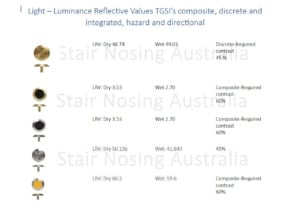Tactile Indicator Requirements
Tactile Indicator Guidelines
Firstly, place tactile indicators across the full width of walking paths, enabling individuals to detect them with a cane or underfoot. Additionally, position warning indicators at the top and bottom of stairs, ramps, and escalators to alert users to potential hazards. Furthermore, ensure that the top of each tactile indicator does not rise more than 4-5 mm above the surface.
Tactile Slip Resistance Information
Moreover, ensure that tactile indicators have a slip-resistant surface in accordance with AS 4586 standards.
Design of Tactile Indicators
Warning Indicators: These indicators serve to alert users to potential dangers. Directional Indicators: On the other hand, these guide individuals along safe paths, typically arranged in long, straight lines.
Tactile indicators requirements
Tactile Luminance Contrast
- Make sure there is enough contrast between tactile indicators and the surrounding surface so people with low vision can see them clearly.
- Specific Applications
- Set the depth of tactile indicators according to the length of the approach or landing.
- If the approach or landing is 600 mm or longer, use a minimum depth of 600 mm.
- If it is less than 300 mm, use a minimum depth of 300 mm.
- Place indicators on landings shorter than 300 mm only if there are continuous handrails on both sides.


